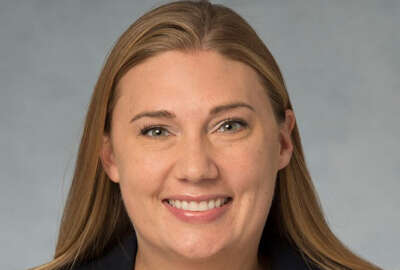
One-on-One with NARFE’s staff vice president for Policy and Programs
As part of the Federal Drive's continuing expansion of coverage of pay, benefits and working conditions for federal employees. The Federal Drive with Tom Temin ...
As part of the Federal Drive’s continuing expansion of coverage of pay, benefits and working conditions for federal employees. The Federal Drive with Tom Temin introduces a new voice, who listeners will hear from in monthly interviews. John Hatton is staff vice president for Policy and Programs at NARFE, the National Active and Retired Federal Employees Association.
Interview transcript:
Tom Temin
Give us a brief overview of what NARFE is all about. Who’s a member? How many members do you have and so on?John Hatton
Sure. So we have around 140,000 members across the country. We’re in every congressional district, every state in the country. Our members, are mostly retirees. But we have active employee members as well. And people, typically, start to look at NARFE membership, as they’re thinking about retirement, now we welcome people in, prior to that, too. But we provide a lot of resources, in terms of how to deal with your federal benefits. So, what mistakes not to make, when applying for retirement, when to retire, what benefits plans to choose on the health benefits side. So in addition, to our advocacy, we do that benefits advice. I oversee both of those programs for NARFE, with their advocacy and federal benefits. But our members span, basically, every agency of the federal government, every branch, both, blue collar and professional.Tom Temin
That was my question. Is it mostly management? Or do you have some of the people that were in [American Federation of Government Employees (AFGE)] and [National Treasury Employees Union (NTEU)]? Or just a mixture?John Hatton
We have a mixture. So we have people in both really. We have, both, union and management backgrounds. And so, we really focus on governmentwide policies, rather than, specific, agency based policies. Unless, it’s something that could be a precedent setting type policy.Tom Temin
Yeah, they say the grave levels everyone.John Hatton
Yeah, it does.Tom Temin
And among the top issues, I think it’s fair to say right now, that you’re looking at and what federal employees are looking, nervously, at is the debt limit debate. The use of the extraordinary measures and each time around, in recent years, these types of things like government shutdowns, seem to take a step further than the last time into unknown territory.John Hatton
Yeah. So first of all, extraordinary measures. The debt limit, actually, was hit on Jan. 19. When that happens, to prevent default, the Treasury Department implements these extraordinary measures. Now, we often get a lot of heartache from our members about what does that mean. Because they are using, the civil service retirement and disability fund and the TSP G Fund. They’re using some accounting gimmicks on those, to prevent default for federal government.Tom Temin
Right. That’s a good word, accounting gimmick. The only real money that’s cash, is people’s TSP accounts. The rest of it is all like, Social Security. It’s all just one big smush of money, that’s either in the form of tax receipts or debt ,that the government generates.John Hatton
The Civil Service Retirement disability fund, is all special issues for treasury securities, the same way the Social Security Trust Fund is. And so, no one’s ever missed a payment on their annuities. No one’s ever not been able to take out their money from the TSP. Because of this and both funds, have always been made whole at the end of it. So, we don’t like the fact that these extraordinary measures are used. But we’re not panicking about it. We don’t think our members should panic about it. What we’re a little bit more concerned about is, this being part of a debate over budget cuts and spending cuts, that could implicate federal retirement and health benefits.Tom Temin
Right. But there’s no evidence that will happen, yet.John Hatton
Not yet. But, clearly, there’s a push for spending cuts in exchange for an increase in the debt limit. Now, President Biden saying, I’m not going to negotiate over the debt limit. But we also, have to look ahead to the next fiscal year and really the next two fiscal years and having a budget, to provide for federal agency spending. And so there’s going to be negotiations over that anyway, which could also lead to spending cuts. And so I’m seeing this as more of a similar scenario, as to when sequestration was put in place. And when they wanted to get rid of sequestration, they had to have mandatory spending cuts. Among the ones that are on the table from think tanks, are things like eliminating or reducing cost-of-living adjustments to federal retiree annuities.Tom Temin
Right. So people would get their basic annuity or get their basic pay. The question is beyond that. Everything’s on the table, really.John Hatton
Yeah, we seen these proposals in the past, we expect to see them again, they’re in some leading think tank proposals. They have not been proposed by Congress, yet. But you saw at the State of the Union, President Biden making it clear that, they don’t want to do Social Security, Medicare cuts. And the Republicans were very clear that, they didn’t want to be for that either. And so, when you take those two big spenders off the table on the mandatory side, there’s not a lot left and federal benefits are one of those things that they could get a lot of money for. So, whether that becomes part of a proposal and whether it actually has a chance of becoming law, are two different questions. But I do think it will be part of the debate.Tom Temin
We’re speaking with John Hatton. He staff vice president for Policy and Programs at the National Active and Retired Federal Employees Association. And another question I wanted to ask you about, is your work for COLA’s, cost-of-living adjustments, specifically, for the [Federal Employees Retirement System (FERS)] retirees. There’s many, almost, most of the federal workforce working now, is under the FERS system. And so that’s, really, the melon ball has gone through the gooses neck, with respect [Civil Service Retirement System (CSRS)].John Hatton
Yeah so, one of the things we’re working on, is for FERS retirees, when inflation is higher than 2%, they don’t get the full COLA. They get either 2%, if it’s in between two and three, or it reduced by 1%. So this year, CSRS and Social Security got an 8.7% COLA, FERS got 7.7%. And now that 1%, oh, it doesn’t seem like a lot. But you compound that over time, over the course of your entire retirement. And it could be just for the average first retiree, it’s 10s of thousands of dollars. And if you have a higher annuity, it’s going to be even more than that. So we’ve been working with some partners in Congress to try to change that. So there’s a bill that was just introduced, recently, this month, the Equal COLA act by Connolly (D-Va.) and Padilla (D-Calif.) in the Senate. And so we’re trying to push that and try to gain support for that bill.Tom Temin
Right. And it’s hard to know what the bipartisan support for that really is. Because often, divided as it is, some Republicans in Congress, do come to the side of federal employees and their advocates advocate.John Hatton
Yeah, that’s true. There’s, definitely, a subset of Republicans in Congress that are good on these issues. Brian Fitzpatrick (R-Pa.) from Pennsylvania, has been a lead sponsor of a lot of these bills. And we’re trying to, obviously, gain as much support as we can and on both sides of the aisle. And it’s not always an even amount on both sides. But we can get people on the Republican side on board.Tom Temin
And interesting issue, which does originate on the Republican side, is that so called Schedule F. And there’s bill for that. It’s almost, in some ways, like looking at a nasty Orangutan. It could really do your harm if it got ahold of you, but because of divided Congress, that forms, a kind of, cage around it. But what’s the latest on Schedule F? And what’s your position, I can guess, on schedule F?John Hatton
We’re opposed to Schedule F. And that was created through executive order, at the end of the Trump administration, to create this large broad exception to the civil service. And that never really had the time to be implemented then. When Biden came in, it was rescinded within his first week of office. But it’s gotten more attention, on both sides of the aisle, whether to codify it from some Republican. It’s gotten attention in the news, in terms of bringing it back, if a new administration comes in after Biden. So there’s been a lot of pushback, from NARFE, other allies off the Hill, plus allies on the Hill, to try to prevent that from coming back. So right now, there’s no danger of that coming back. But if there’s a switch in administration’s, there is. And what we’ve been trying to do, is get legislation passed to prevent that from ever happening.Tom Temin
We’ll see what happens with that bill. But yeah, I think that’s going to be debated. And it’s kind of one of those things, that’s going to rear its head from time to time.John Hatton
Yeah, it’s being reintroduced, I believe this week. Kaine (D-Va.) in the Senate and Connolly in the House. Also, with Fitzpatrick onboard in the House. There was a push to include it in the National Defense Authorization Act, last year. It did not get in and did not have bipartisan support.
Copyright © 2024 Federal News Network. All rights reserved. This website is not intended for users located within the European Economic Area.
Tom Temin is host of the Federal Drive and has been providing insight on federal technology and management issues for more than 30 years.
Follow @tteminWFED
Related Stories

For many federal employees, health and retirement benefits are what’s keeping them on the job




